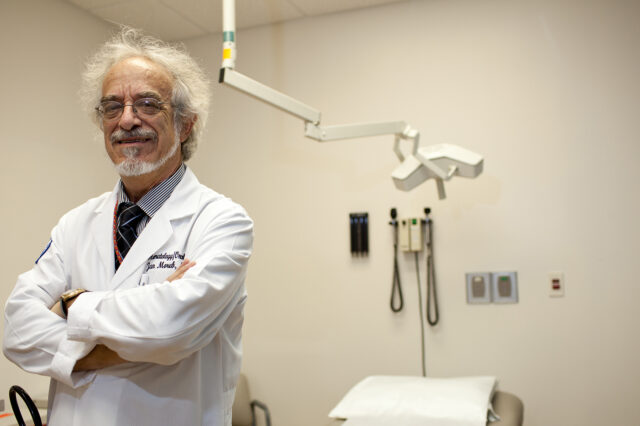UF physician, colleagues identify successful blood cancer therapy

A new treatment regimen can help some patients who have blood cancer to live disease-free longer, University of Florida researchers and colleagues have found.
Low doses of a drug called lenalidomide can help hold off the return of multiple myeloma after bone marrow transplantation. Patients who took the drug to maintain health also lived longer than those who did not take the drug.
“In choosing maintenance therapy we look at a few things,” said study co-author Jan S. Moreb, M.D., clinical director of hematologic malignancies in the UF College of Medicine’s division of hematology/oncology and a member of the UF Shands Cancer Center. “One is quality of life, the other is, does it prolong remission? And the bottom line is, do patients have longer survival? — this drug fits the bill.”
The findings were published May 10 in the New England Journal of Medicine. Two other international trials in the same issue of the journal also support lenalidomide use for maximizing the duration of cancer remission.
Multiple myeloma occurs when an overproduction of blood cells leads to tumors in the bone marrow. People 67 years and older are at greatest risk, and men are more likely than women to develop the disease. More than 16,500 people in the U.S. were diagnosed with multiple myeloma and almost 11,000 people died from it in 2007, the latest year for which there is comprehensive data, according to the Centers for Disease Control and Prevention.
Bone marrow transplantation followed by drug treatment has emerged as an effective therapy, but the drugs in current use are too toxic to be used long term. One such drug is thalidomide, known for causing a rash of birth defects in the 1950s and 1960s.
Lenalidomide, a much less toxic relative, is FDA-approved for use when myeloma resurfaces after a period of remission. The researchers wanted to see whether it could also be used “off-label” to provide a new, safer option to keep disease away after stem cell transplantation has removed the cancer.
The drug, a tablet that patients can take at home, exerts its anti-cancer effect in various ways, including preventing the formation of blood vessels that feed tumors.
In the study, which ran from 2005 to 2009, 460 patients younger than 71 who had had a blood stem cell transplant were randomly assigned to receive low doses of either lenalidomide or a formulation that did not contain the drug.
Patients on the test drug were disease-free longer than others. They went three years and three months before disease progressed, on average, whereas those not on the drug got sick again after only a year and nine months.
Not only did the drug slow disease progression, it also prolonged life. At the time of analysis, 85 percent of those who took the drug had survived, compared with 77 percent of those who had not taken it.
“That’s a pretty important landmark to see, because ultimately that’s our goal — to improve overall survival,” said Sagar Lonial, M.D., a professor and vice chairman of clinical affairs at Emory University School of Medicine department of hematology and medical oncology. Lonial was not involved in the current study.
The drug did have some negative effects, namely a small increase in the rate of other types of cancer such as breast cancer and leukemia. Eighteen patients who took the drug developed other cancers, compared with six who had not taken the drug.
Even so, the rate of survival without disease progression remained higher among patients who had taken the drug.
“I would say it is worth it,” said the study’s lead author Philip McCarthy, M.D., a professor of oncology and director of the blood and marrow transplant program at Roswell Park Cancer Institute in Buffalo, N.Y. “Obviously patients need to discuss this with their physicians, but we think the benefit outweighs the risk.”
The researchers say a list of criteria that make patients good candidates for the treatment must be developed. And more studies have to be done to learn whether patients benefit equally or whether different patients require different treatment strategies.
“The current objective is to define which patients gain the greatest benefit, and which need more intensive or less intensive approaches,” Lonial said.